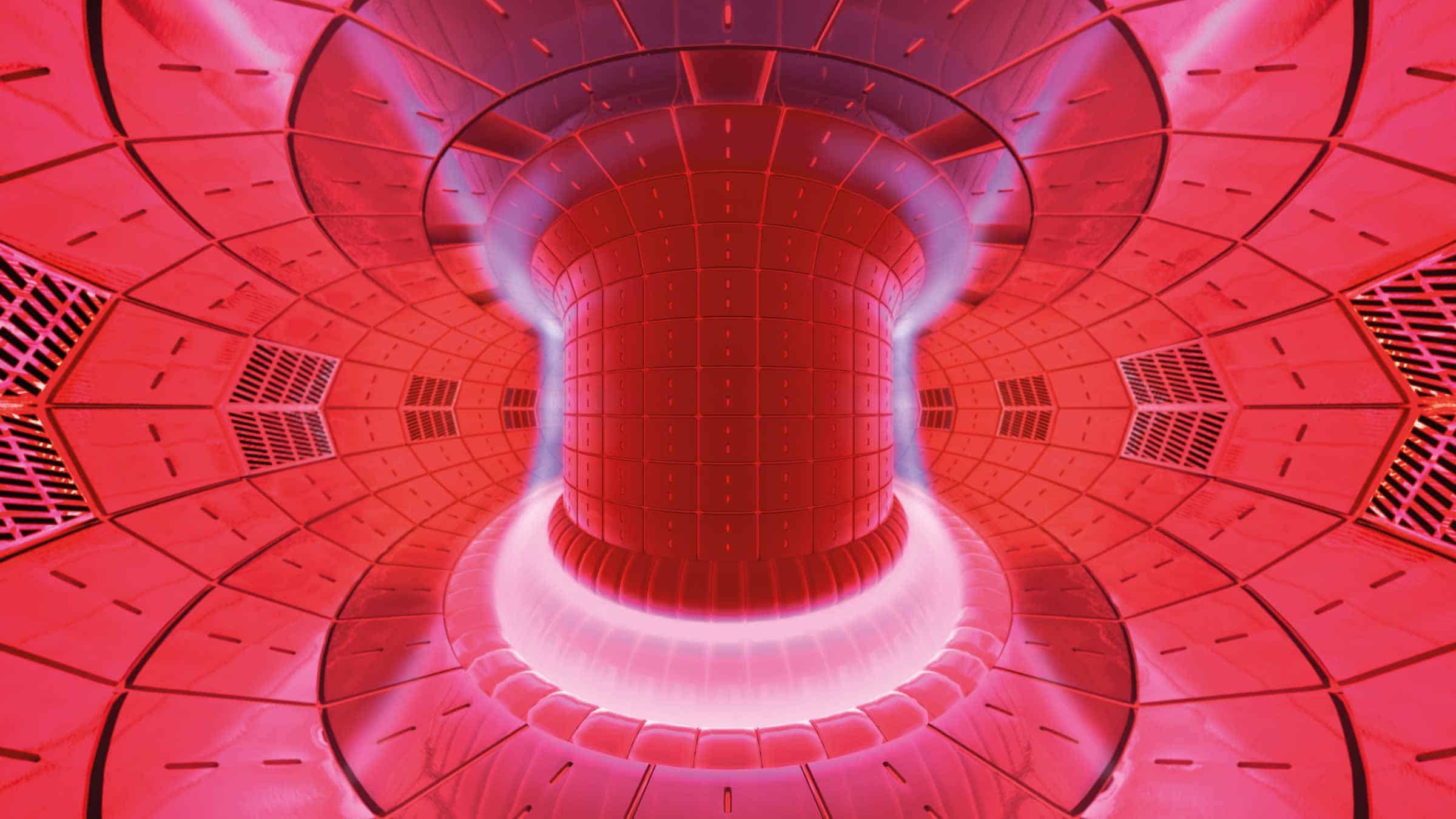Fusion energy record smashed by Joint European Torus facility

Hotter than the Sun: researchers on the Joint European Torus nuclear-fusion experiment have used a deuterium–tritium fuel mix for the first time since 1997. (Courtesy: UKAEA)
The Joint European Torus (JET) nuclear-fusion experiment based in Oxfordshire, UK, has more than doubled the amount of fusion energy produced in a single “shot” – smashing a previous record that JET has held since 1997. Officials today announced that during an experiment in late 2021, JET achieved 59 megajoules (MJ) of fusion energy, beating the previous record of 22 MJ.
JET, which was built in 1983, is operated by the Culham Centre for Fusion Energy (CCFE) – the UK’s national fusion research laboratory. It is a fusion reactor that uses magnetic confinement to hold a hot plasma reaching temperatures of 150 million kelvin, 10 times hotter than the centre of the Sun.
Fusion, which powers stars, occurs when two light nuclei, such as hydrogen and its isotopes, fuse together to produce a heavier nucleus while releasing energy. Designed to study the conditions approaching those in a fusion power plant, JET is the only device currently operating that can use the deuterium–tritium fuel mix, of the kind that will be used for commercial fusion power.
Experiments on JET are funded by the EUROfusion consortium of 30 member institutes from across Europe including the UK, Switzerland and Ukraine. JET famously carried out the world’s first controlled release of deuterium–tritium fusion in 1991. Six years later it produced a five second shot that produced 22 MJ of total energy and a peak 16 MW of fusion power for about 0.15 seconds. As the pulse was driven by 25 MW of input power, this gave a ratio of fusion power to heating power as 0.64 – a world record that remains today.
Record breaking
Following that experiment, JET went back to using a deuterium plasma and much of JET’s work has been in preparation for the ITER experimental fusion reactor, which is currently under construction in Cadarache, France. This includes plasma-physics research, systems testing and materials investigations. A £60m upgrade to JET was completed in 2011 that involved replacing the carbon tiles from the inner reactor wall with beryllium and tungsten – to test the materials that ITER will use. ITER will begin deuterium–tritium experiments in December 2035.
 Plasma shot in JET on 21 December 2021 that released a record 59 megajoules of fusion energy. (Courtesy: EUROfusion consortium)
Plasma shot in JET on 21 December 2021 that released a record 59 megajoules of fusion energy. (Courtesy: EUROfusion consortium)Over the past few years, JET has been upgraded to begin operating with tritium again and on 21 December researchers at the facility created a deuterium–tritium fusion shot that produced an energy of 59 MJ over five seconds.
The 11 MW produced (with 40 MW of input power) is lower than that achieved in 1997, resulting in a ratio of fusion power to heating power of about 0.3. However, the power was sustained over a longer period of five seconds. Indeed, officials say that they now want to focus on producing “sustained” fusion energy rather than optimising a brief peak performance.
“These landmark results have taken us a huge step closer to conquering one of the biggest scientific and engineering challenges of them all,” says Ian Chapman, chief executive of UKAEA. “It’s clear we must make significant changes to address the effects of climate change, and fusion offers so much potential. Our world needs fusion energy.”
Future aims
When it begins using deuterium and tritium in 2035, ITER will seek to generate about 500 MW over 300 seconds using a plasma heating of 50 MW, and the results by JET agree with predictions and give confidence that ITER will work as planned.
“A sustained pulse of deuterium–tritium fusion at this power level – nearly industrial scale – delivers a resounding confirmation to all of those involved in the global fusion quest,” noted ITER director general Bernard Bigot. “For the ITER project, the JET results are a strong confidence builder that we are on the right track as we move forward toward demonstrating full fusion power.”
READ MORE

Ignition pending
The CCFE says that the experience of operating with tritium is also helping to prepare to operate a new facility on the Culham campus – H3AT – that will be one of the largest R&D facilities for tritium in the world once opened in 2024. It will be required when the UK’s prototype fusion power plant – Spherical Tokamak for Energy Production (STEP) – comes online in the 2040s.

Michael Banks is news editor of Physics World magazine.
Δεν υπάρχουν σχόλια:
Δημοσίευση σχολίου